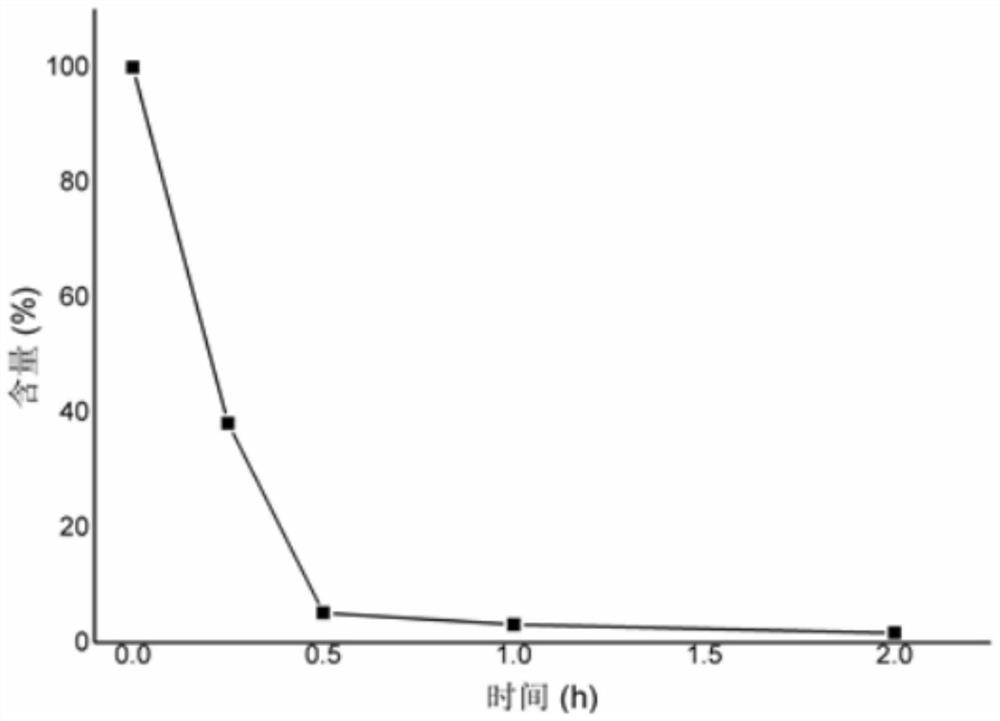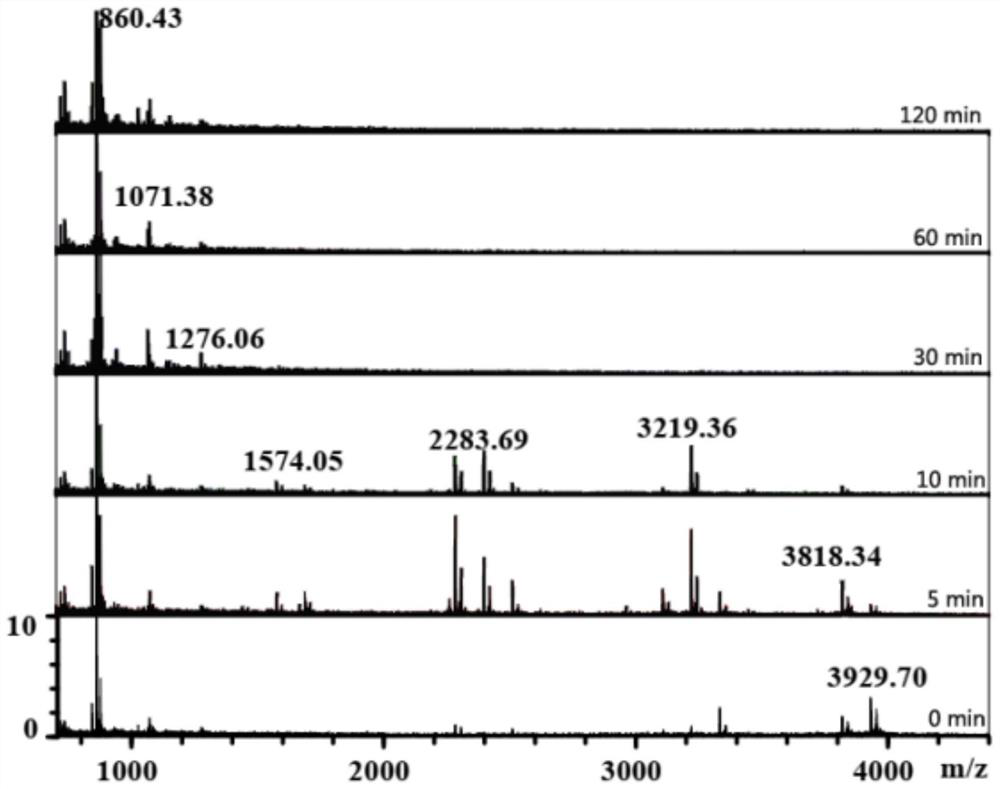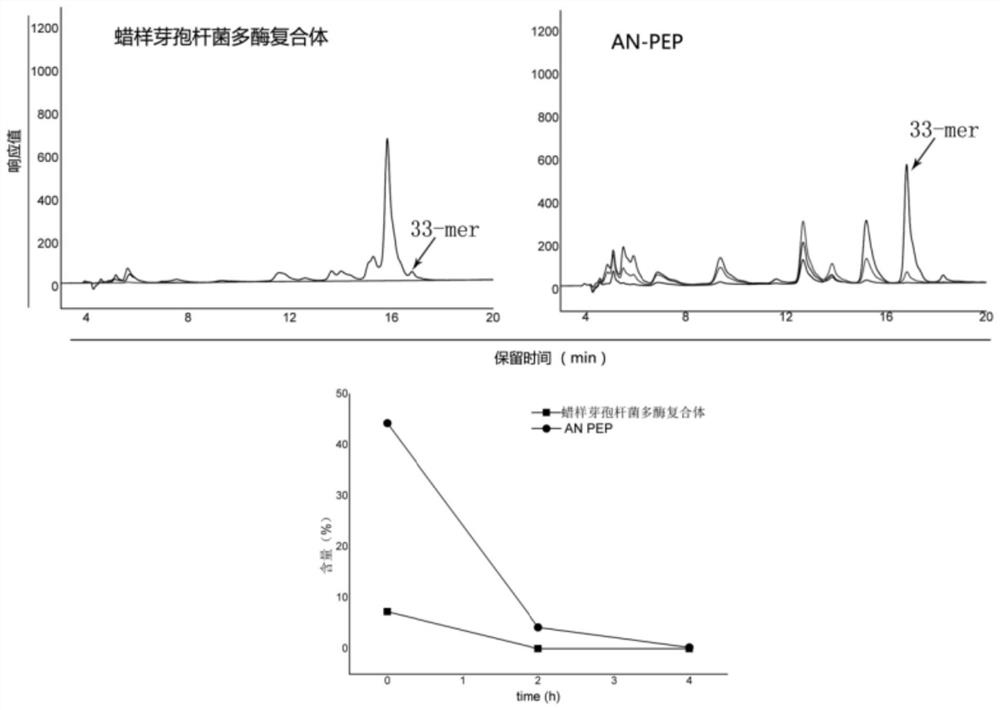Multi-enzyme complex capable of efficiently degrading gluten protein and application of multi-enzyme complex
A technology of gluten protein and complex, which is applied in the field of multi-enzyme complexes that efficiently degrade gluten protein, can solve the problem that gluten protein is difficult to be completely hydrolyzed, achieve effective degradation, efficient degradation, and reduce safety risks
- Summary
- Abstract
- Description
- Claims
- Application Information
AI Technical Summary
Problems solved by technology
Method used
Image
Examples
Embodiment 1
[0027] Embodiment 1: the preparation of bacillus cereus multienzyme complex
[0028] (1) In SCB solid medium (starch 10g·L -1 , Casein 3.0g·L -1 、KNO 3 2.0g·L -1 , NaCl2.0g·L -1 、K 2 HPO 4 2.0g·L -1 , MgSO 4 0.05g·L -1 , CaCl 2 0.02g·L -1 , FeSO 4 0.01g·L -1 , pH value 7.2) was inoculated with Bacillus cereus AFA01, cultured at 37°C for 2 days, the cells were collected, and the cells were resuspended with 50 mM Tris-HCl (pH 8.5).
[0029] (2) Suspend the cells and sonicate on ice (300W, 2s, interval 3s, total time 15min), add CHAPs to make the final content reach 1.2% (w / v), place at 4°C for 1h, mix every 10min. Then centrifuge at 12000g for 10min, take the supernatant, and pass through a 0.22μm filter membrane.
[0030] (3) The DEDA FF anion exchange column was equilibrated with 20 mM Tris-HCl buffer (pH 8.5, containing 0.5% w / v CHAPs). After loading the sample, carry out gradient elution with 0-0.6M NaCl, and collect the active components.
[0031] (4) T...
Embodiment 2
[0035] The gliadin decomposition experiment was carried out with the multi-enzyme complex obtained in Example 1.
[0036] The concentration of gliadin is 0.5 mg / mL, the concentration of multi-enzyme complex is 0.01 mg / mL (0.01‰), the enzymatic hydrolysis temperature is 37°C, and the pH of the buffer is adjusted to 7.0. Sampling was used to determine the change of gliadin, and the detection method was referred to "Research on the Detection Method of Zein" published by Liu Zhenyu et al. see results figure 1 , it can be found from the figure that the use of multi-enzyme complex can reduce the gliadin content to 5% within 30 minutes, and reduce the gliadin content to below 2% in 120 minutes.
Embodiment 3
[0038] The celiac disease peptide decomposition experiment was carried out with the multi-enzyme complex obtained in Example 1.
[0039] The celiac peptide (33-mer) concentration was 0.5 mg / mL, the multi-enzyme complex concentration was 0.005 mg / mL, the enzymatic hydrolysis temperature was 37°C, and the buffer was adjusted to pH 7.0. Samples were taken to determine the degradation of 33mer, and the detection method was referred to "Detection of serum peptides in patients with lung squamous cell carcinoma by MALDI-TOF-MS and analysis of its correlation with chemotherapy efficacy" published by Zhao Guanhua et al. ("Chinese Journal of Lung Cancer", Issue 5, 2017). see results figure 2 , it can be seen from the figure that the multi-enzyme complex can degrade all the complete 33-mer within 5 minutes, and the remaining polypeptides are basically less than 9 peptides at 30 minutes, and the celiac T cell epitope in the 33-mer is destroyed.
PUM
 Login to View More
Login to View More Abstract
Description
Claims
Application Information
 Login to View More
Login to View More - R&D
- Intellectual Property
- Life Sciences
- Materials
- Tech Scout
- Unparalleled Data Quality
- Higher Quality Content
- 60% Fewer Hallucinations
Browse by: Latest US Patents, China's latest patents, Technical Efficacy Thesaurus, Application Domain, Technology Topic, Popular Technical Reports.
© 2025 PatSnap. All rights reserved.Legal|Privacy policy|Modern Slavery Act Transparency Statement|Sitemap|About US| Contact US: help@patsnap.com



